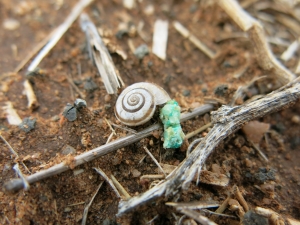Baiting snails – success is all about the timing
Baiting snails – success is all about the timing
Author: GRDC Adelaide office | Date: 09 Apr 2020

Timing is everything when it comes to effective baiting of snails.
And the optimal time to bait snails is in autumn before egg laying begins – a message to grain growers that has been reinforced through ongoing research.
To inform growers’ baiting practices, the seasonal activity patterns of snails in different conditions across eight sites in South Australia and Western Australia continues to be investigated through a Grains Research and Development Corporation (GRDC) investment.
This research, led by the South Australian Research and Development Institute (SARDI), the research division of Primary Industries and Regions SA, has found that:
- For common white snails in SA and WA, reproduction generally occurs from April to mid-spring.
- The onset of reproduction can vary greatly from year to year and is largely dependent on rainfall. A wet start can lead to earlier snail reproduction.
- Snails ‘shut down’ their breeding activities between August to October depending on the finish to the season.
- Snail baits appear to kill snails more efficiently during times of the year coinciding with snail reproduction.
SARDI entomologist Helen Brodie says the aim of baiting is to control snail populations by knocking out mature snails before significant reproduction has occurred.
“Snails are most efficiently killed by baiting in early autumn. At this time, prior to and during reproduction, snails are active, hungry and the most vulnerable to the bait active ingredients,” Ms Brodie says.
Ms Brodie details her research in a new GRDC podcast, as well as in a GRDC Paddock Practices article.
-
GRDC PodcastPodcast
GRDC Podcast: Bait, bash or burn – latest advice on snail control
Snails are one of those pests that can’t be controlled by any one tool – but a significant amount of research is happening across the country to give growers effective control options.
Date: 08 Apr 2020
Introduced round and conical snails cause significant economic losses to Australian growers and require an effective year-round management response, one element of which is baiting.
Ms Brodie says of the few molluscicide active ingredients available, metaldehyde is the most commonly used.
“Unfortunately, snail baits in general are not attractive to snails over distance,” Ms Brodie says.
“They will not seek the baits out, so the baits need to be placed at a time and sufficient density to ensure snails encounter them before the baits degrade and become less effective.
“Baits must be applied just before prolonged periods of snail activity to ensure pellet encounter. If growers are unsure whether snails are active, then it is best to bait a small area and check for dead snails after a few days.”
It is important to gain an even spread of snail bait by calibrating spreaders for the selected bait product, and monitoring outputs.
Optimal baiting efficacy requires at least 30 pellets per square metre. In areas of higher snail densities, up to 60 pellets/m2 may be required to ensure adequate rates of encounter. If this is above the registered rate of the product, repeat applications may be necessary, ensuring label directions are followed.

Ms Brodie says it is important for baits to be stored correctly and to be deployed at the right time to ensure maximum effectiveness.
“Environmental conditions will affect bait efficiency. We found that exposure of baits to high temperatures did reduce the active ingredient concentration over time, but UV exposure had no effect,” she says.
“Iron chelate products are less effective if exposed to rainfall above 35 millimetres, however, extended high rainfall will break down most bran-based pellets regardless of active ingredient.
“It is important to be aware of the temperature and rainfall forecast before spreading baits, and to store snail pellets in cool and dry conditions.
“Storing baits in a shed where the temperature regularly exceeds 40 degrees Celsius (°C) can cause bait degradation.”
Ms Brodie is also involved in GRDC-invested collaborative research, led by CSIRO in partnership with SARDI, looking at biological control of snails. This work has involved evaluation of a Moroccan parasitic fly strain, which scientists hope to deploy as a biological control tool targeting the introduced conical snail.
The fly species is a natural parasitoid (parasite that eventually kills its host) of the snail species in its native habitat across Europe and northwest Africa and was chosen for its genetic and climatic credentials.
More information about the biological control research can be found in a GRDC GroundCover™.
More information on snail control and the latest research insights can be found in the GRDC Grains Research Update Paper and in the GRDC Snail Bait Application Fact Sheet.
Contact Details
For Interviews
SARDI-PIRSA Communications
PIRSA.Media@sa.gov.au
Contact
GRDC Adelaide office Communications Manager – South
(08) 8198 8400
media@grdc.com.au
GRDC Project Code: DAS00134, DAS00160, CSE00061, DAS300, DAS00174, YPA0002,


